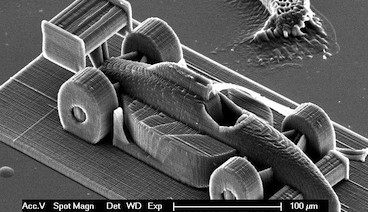Superfast 3D-Nanoprinter Breaks World Record
March 13, 2012
on
on

Researchers of the Vienna University of Technology set a new world record in high-precision printing fabricating a nanoscale race car in less than 5 minutes. A process that previously would take several days.
The researchers use a technique called two-photon-polymerization (2PP). Unlike most additive manufacturing technologies 2PP does not build up a structure layer-by-layer. Instead an ultrashort pulse laser fires photons at a liquid resin which hardens when exposed to light.
The resin consists of monomers which can bind to each other to form polymers. Polymerization occurs when the monomers are hit with two photons at the same time. The resin only hardens at the focal point of the laser beam where light intensity is high enough.
With 2PP it’s easier to build structures with massive overhangs because layers can be added independent of each other. Whereas in layer-by-layer printing supporting material is needed in the manufacturing process to prop up the overhanging layers.
The drawback of 2PP until now was its long processing time. The average process speed was measured at several 100µm/s. An interdisciplinary collaboration at the UT Vienna has improved speeds considerably.
Engineers of the Institute of Materials Science and Technology designed a new mechanical set up of movable mirrors to guide the laser beam while chemists at the Institute of Applied Synthetic Chemistry synthesized a novel photopolymerizable material.
With improvements to both the resin and the laser guiding technique UT Vienna has measured speeds of 5m/s.
The fabrication of a 330x130x100µm3 race car in under 5 minutes can be seen in the video below.
Photo: Vienna University of Technology
Sources: Tweakers.net, newscientist.com, Vienna University of Technology
The researchers use a technique called two-photon-polymerization (2PP). Unlike most additive manufacturing technologies 2PP does not build up a structure layer-by-layer. Instead an ultrashort pulse laser fires photons at a liquid resin which hardens when exposed to light.
The resin consists of monomers which can bind to each other to form polymers. Polymerization occurs when the monomers are hit with two photons at the same time. The resin only hardens at the focal point of the laser beam where light intensity is high enough.
With 2PP it’s easier to build structures with massive overhangs because layers can be added independent of each other. Whereas in layer-by-layer printing supporting material is needed in the manufacturing process to prop up the overhanging layers.
The drawback of 2PP until now was its long processing time. The average process speed was measured at several 100µm/s. An interdisciplinary collaboration at the UT Vienna has improved speeds considerably.
Engineers of the Institute of Materials Science and Technology designed a new mechanical set up of movable mirrors to guide the laser beam while chemists at the Institute of Applied Synthetic Chemistry synthesized a novel photopolymerizable material.
With improvements to both the resin and the laser guiding technique UT Vienna has measured speeds of 5m/s.
The fabrication of a 330x130x100µm3 race car in under 5 minutes can be seen in the video below.
Photo: Vienna University of Technology
Sources: Tweakers.net, newscientist.com, Vienna University of Technology
Read full article
Hide full article


Discussion (0 comments)